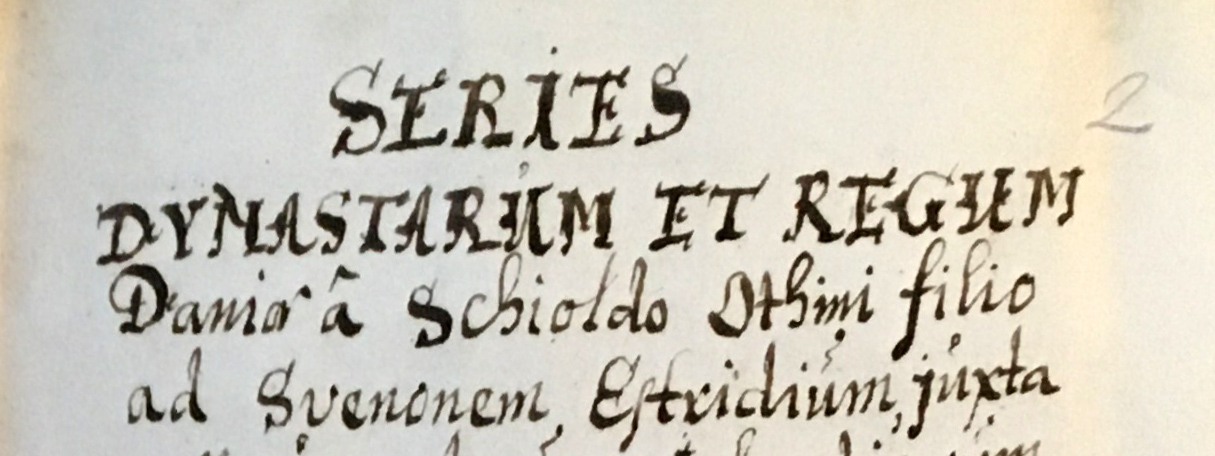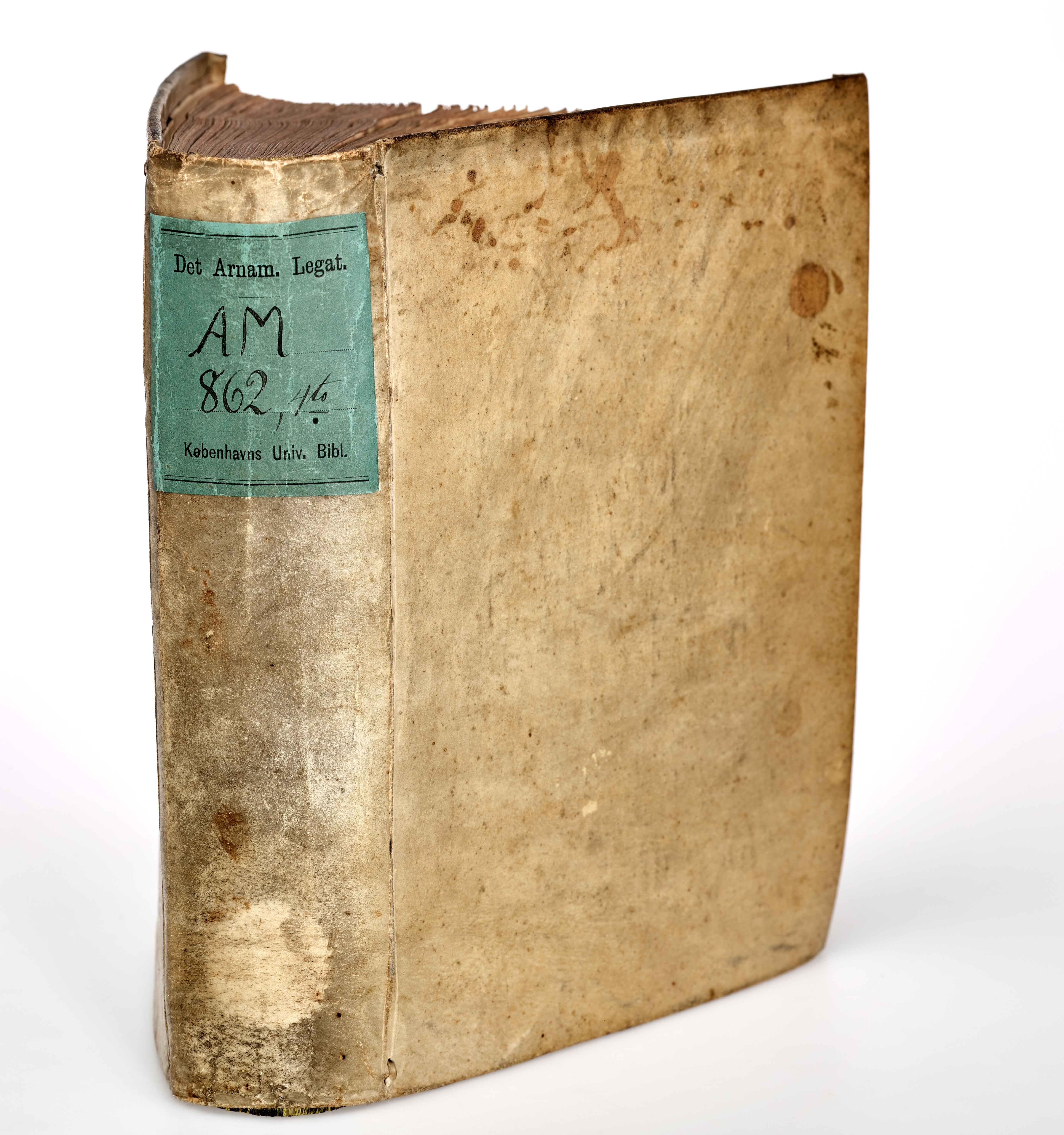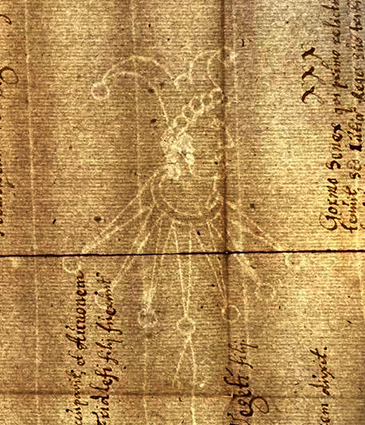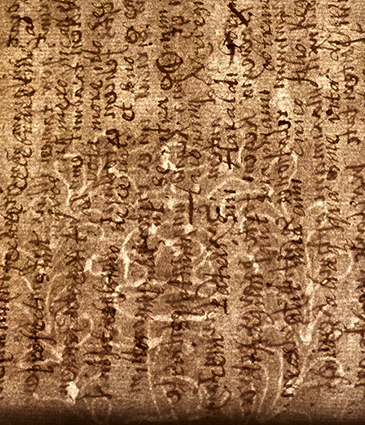Revising Danish Royal Genealogies Anno 1664
Since the time of Saxo Grammaticus and his monumental Gesta Danorum, Danish royal lineage was traced back to the legendary ruler named Dan. This changed, however, in the middle of the seventeenth century, when Thormodus Torfæus, royal antiquarian at the court of Frederik III, composed his controversial treatise Series dynastarum et regum Daniæ and replaced Dan with Skjöld at the beginning of the dynasty.

Title page of Series dynastarum et regum Daniæ by Tormodus Torfæus in AM 862 4to
Torfæus and his Series dynastarum
Series dynastarum et regum Daniæ (Succession of rulers and kings of Denmark) is a treatise on the oldest Danish royal genealogies written by Þormóður Torfason (1636–1719), known as Thormodus Torfæus, an Icelander employed as a royal antiquarian and historiographer at the court of Dano-Norwegian monarchs. After his fruitful but short career as the royal translator of Old Norse-Icelandic sagas in the service of Frederik III (r. 1648–1670), Torfæus was given the assignment of compiling an account of Danish royal genealogies based on Old Norse-Icelandic sources. He completed this assignment in 1664, when he presented the king with a beautiful volume in quarto containing his Series dynastarum (today the manuscript GKS 2449 4to held at the Royal Danish Library in Copenhagen). We can only speculate whether the controversial contents of this volume, breaking with the traditional succession of Danish rulers established by Saxo, had anything to do with the almost forty-year delay between completion of the work and its publication, but it was not until 1702 that a highly revised version of the treatise was printed.
The fate of Series dynastarum between 1664 and 1702 is unclear, but thanks to the preserved correspondence between Árni Magnússon and Torfæus, we know that around 1690 Torfæus, following Árni Magnússon’s encouragement, had taken up the task of preparing his work for print. The collaboration between the two men resulted in extensive differences between the printed version of 1702 and the version of 1664 preserved in extant manuscripts. Árni Magnússon must be responsible for significant revisions, as Torfæus wrote in a letter to Árni that he could barely recognize his own work:
Præfationem hefr hann lofad mer at giora, og þad kann hann betr enn eg, þvi hann er nu betr kunnugr i bokinni enn eg, þvi þegar eg conferera þetta vid mina utskrifft, þa er allt inversum. (Kålund 1916, 365)
He [i.e. you] promised me to prepare an preface [to Series dynastarum], and can do it better than me, because he is now more familiar with the book than I am, for when I compare it with my copy, everything is changed.
The Arnamagnæan Manuscript

For almost a half century Series dynastarum circulated exclusively in manuscript form. AM 862 4to is one of three Arnamagnæan manuscripts preserving this work in its 1664 state. This modest volume in quarto consists of 208 paper leaves of 200 ×155 mm in size gathered in twenty-seven quires.
The text must have been written between 1664 and 1667, as on the recto side of the first leaf an ownership note reads “Theodorus Thorlacius possidet ex donation Autoris. Hafn: 1667.” (Theodorus Thorlacius owns from donation of the author. Copenhagen 1667). This note indicates that the manuscript was previously owned by Þórður Þorláksson (1637–1697), also known as Theodorus Thorlacius, who was bishop of Skálholt in Southern Iceland and who received the manuscript directly from Torfæus. The two men most likely met personally in Copenhagen, as it is known that Thorlacius came to Copenhagen in 1667 to complete his master’s degree and at the same time Torfæus also came to Copenhagen in order to receive his appointment as a royal antiquarian.
The whereabouts of AM 862 4to after 1667 are unknown, other than that it had to come back to Copenhagen at some point prior to entering the Arnamagnæan Collection, since another ownership note reads: “Emi in auctione Lützovianá | Hafniæ Anno 1714.” (Bought at Lützow’s auction. Copenhagen Year 1714). This note, written in Árni Magnússon’s own hand, indicates that Árni bought this manuscript at the auction of the Danish nobleman Frederik Lützow’s books, which took place in Copenhagen on 15 January 1714. What convinced Árni to purchase this manuscript is unknown, especially if we consider that the revised version of Series dynastarum had been published twelve years earlier. One of the more interesting features of this manuscript are the foldouts with various genealogical tables, which could have attracted Árni’s attention. One of them appears by the end of the volume and presents the genealogical table of Danish rulers under the title Catalogus Monarcharum et Regum Daniæ Juxta tenorem Annalium Islandicorum conscriptus (A list of monarchs and kings of Denmark written according to chronicles of the Icelanders) (Figure 1).

This foldout is interesting not only due to its historiographical relevance, as it presents Skjöld, a son of Oðin, as the first ruler of Denmark, but also due to its book historical value. It is made of one sheet of watermarked paper which includes a seven-pointed-collar foolscap watermark and a countermark with the initials PR (Figure 2a). While there are no examples known to me of this watermark attested in early modern Danish manuscripts, AM 862 4to serves as good comparative material for other volumes made of the same paper, because the writing of this manuscript must have taken place between 1664 and 1667.
It is worth mentioning that not only the foldout but also the main bulk of the manuscript is made of this type of paper. In some quires, however, there is another type of paper, watermarked with the royal cipher of Frederik III and without any countermark (see Figure 2b). The paper, marked with a crowned “F3” within a wreath, was produced at the Strandmølle paper mill north of Copenhagen in the early days of the mill and is attested in various Icelandic and Danish manuscripts from ca. 1660. The cherry on top for book historians is that the work, dedicated to Frederik III, is partially written on paper watermarked with his royal cipher.
Contact
 Katarzyna Anna Kapitan is H.M. Queen Margrethe II Distinguished Research Fellow at the Museum of National History at Frederiksborg Slot.
Katarzyna Anna Kapitan is H.M. Queen Margrethe II Distinguished Research Fellow at the Museum of National History at Frederiksborg Slot.
Web: https://www.kakapitan.com/
E-mail: kak@dnm.dk
Acknowledgments
With thanks to Natasha Fazlic & Suzanne Reitz for their help and support.
Bibliography
Fiskaa, Haakon Mathiad, and Ove K. Nordstrand. 1978. Paper and Watermarks in Norway and Denmark. Monumenta Chartæ Papyraceæ Historiam Illustrantia 14. Amsterdam: Paper Publications Society.
Ilsøe, Harald. 2007. Biblioteker Til Salg. Om Danske Bogauktioner Og Kataloger 1661-1811. Copenhagen: Museum Tusculanum.
Kålund, Kristian. 1916. Arne Magnusson, Brevveksling med Torfæus. Copenhagen: Gyldendal.
Páll Eggert Ólason. 1948–1952. Íslenzkar æviskrár frá landnámstímum til ársloka 1940. 5 vols. Reykjavík: Hið íslenska bókmenntafélag.
Rottensten, Birte, and Ebba Waaben. 1987. Danske vandmærker & papirmøller 1570-1695. Second edition. Copenhagen: Konservatorskolen, Det Kongelige Danske Kunstakademi.
Contribute to Manuscript of the Month
Have something to say about one or more manuscripts in the Arnamagnæn Collection? Contribute to the column Manuscript of the Month to get your research out there! Write to Seán Vrieland (sean.vrieland@hum.ku.dk) for more details.


